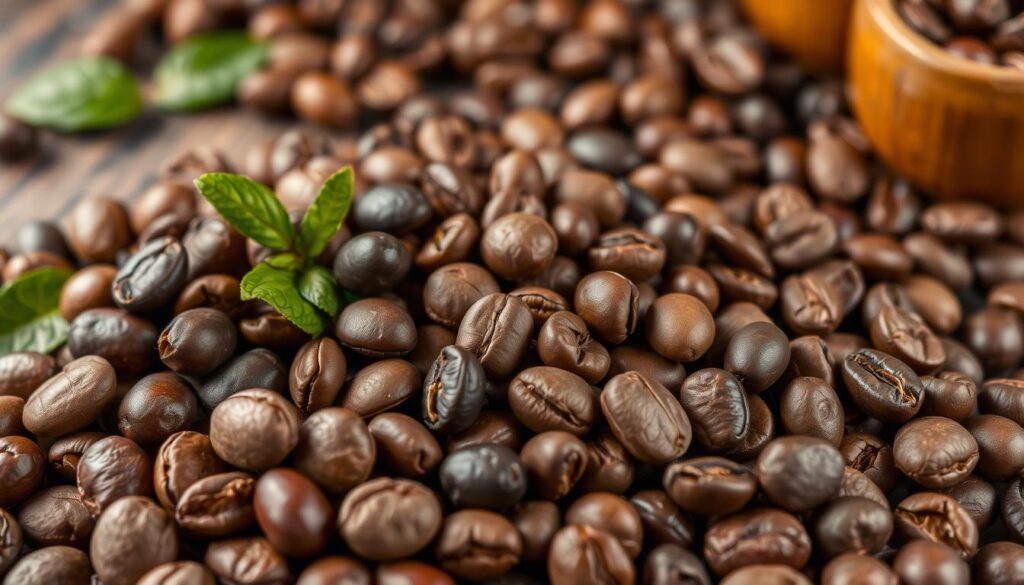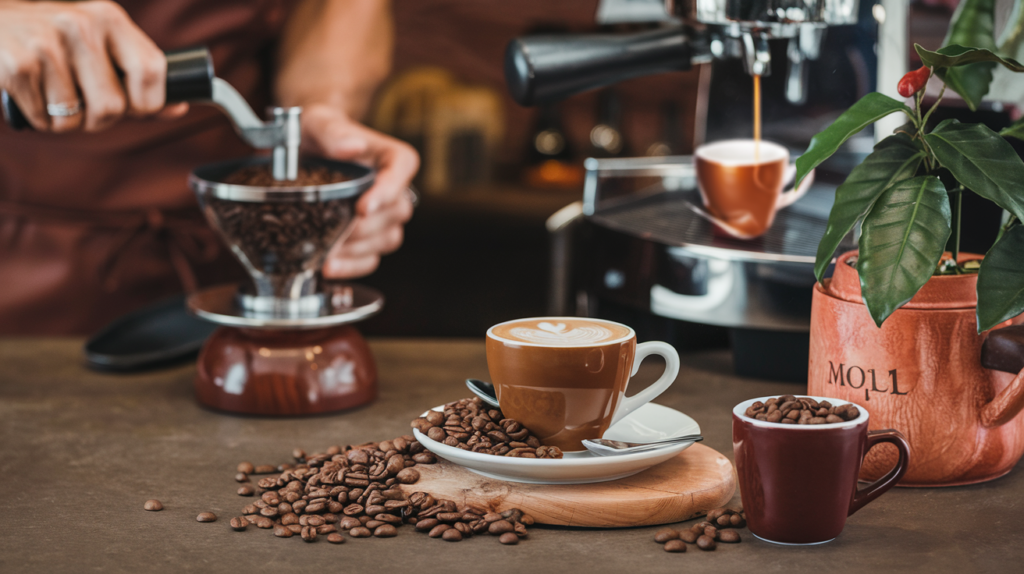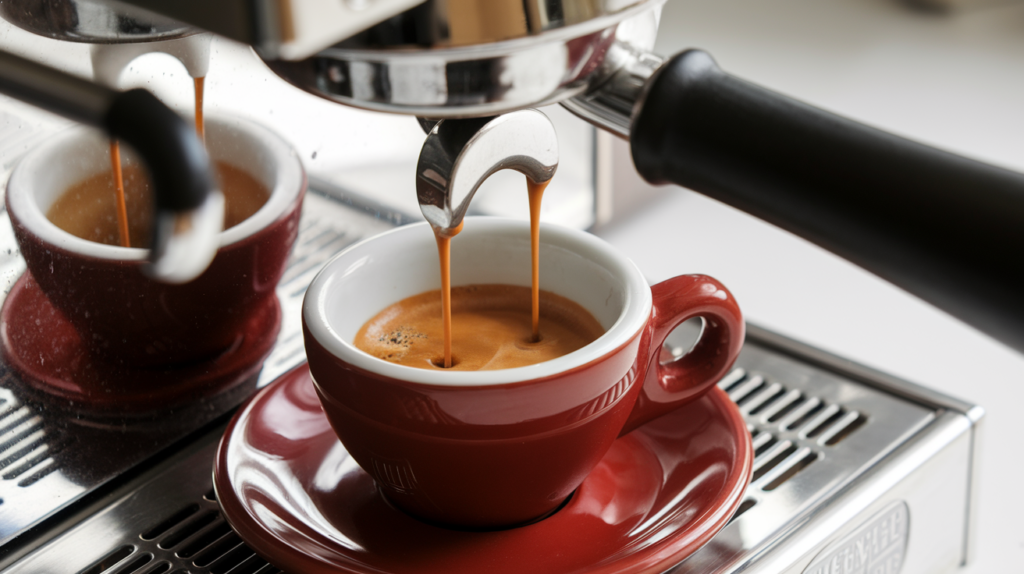If you love making coffee at home or enjoy trying new coffee flavors, this guide is for you. We’ll explore the many types of espresso beans. You’ll learn about their unique tastes, flavors, and what makes them special.
From the famous Arabica to the strong Robusta, we’ll dive into the details. This will help you choose the perfect espresso for your taste.
Espresso is loved for its deep flavor and smooth crema. But did you know there’s a whole world of espresso beans out there? Each one has its own taste and smell.
In this guide, we’ll share the secrets of each espresso bean type. You’ll learn how to improve your coffee and find your favorite espresso.
Understanding the World of Espresso Beans
Espresso beans are special, grown and processed to bring out a deep, rich flavor. This flavor is what makes espresso so unique. But what makes these beans different, and how do roasting and processing affect their taste?
What Makes Espresso Beans Special
Espresso beans are a mix of Arabica and Robusta beans. They’re chosen for their perfect balance of acidity, body, and crema. The beans are roasted to a medium or dark level. This process caramelizes the sugars and brings out the complex flavors that espresso lovers enjoy.
The Role of Roasting in Espresso
The espresso roast profiles are key to the final taste. Medium roasts highlight the bean’s natural flavors. Dark roasts, on the other hand, offer a bolder taste with hints of caramel and chocolate. The roasting also affects the beans’ oils, which are crucial for the crema on top of a good espresso.
Bean Processing Methods
The espresso bean origins and how they’re processed also shape the flavor. Wet-processed beans have a cleaner taste, while dry-processed beans are known for their fruity or earthy notes. Knowing these differences helps espresso fans find their favorite flavors and explore the wide world of espresso beans.
| Processing Method | Flavor Profile |
|---|---|
| Wet Processing | Cleaner, more refined taste |
| Dry Processing | Pronounced fruit or earthy character |
“The pursuit of the perfect espresso is a journey of discovery, exploring the intricate interplay of beans, roasts, and processing methods.”
Types of Espresso Beans
Espresso beans are key to the flavor of your coffee. There are two main types: arabica espresso beans and robusta espresso beans. Each type has its own special qualities that coffee lovers enjoy.
Arabica Espresso Beans
Arabica beans are the top choice for espresso. They’re loved for their rich flavors and soft acidity. Grown at high altitudes, they mature slowly. This makes them sweeter and more complex.
Robusta Espresso Beans
Robusta espresso beans have a strong and intense taste. They’re easy to grow and have more caffeine. This makes them great for a bold and energizing espresso.
| Characteristic | Arabica Espresso Beans | Robusta Espresso Beans |
|---|---|---|
| Flavor Profile | Complex, delicate, and nuanced | Bold, intense, and higher in caffeine |
| Growing Conditions | Higher elevations, slower maturation | Lower elevations, easier to grow |
| Acidity | Higher acidity, contributing to a brighter taste | Lower acidity, resulting in a more muted flavor |
| Crema Formation | Produces a rich, creamy crema | Produces a thinner, less creamy crema |
Knowing the difference between arabica espresso beans and robusta espresso beans is crucial. It helps you choose the right beans for the perfect espresso. Next, we’ll explore the unique qualities and benefits of each type.
Arabica Beans: The Premium Choice
Arabica espresso beans are the top pick for coffee lovers. They’re known for their smooth taste and complex flavors. These beans come from the arabica coffee plant and are loved by coffee experts everywhere.
Flavor Profile and Characteristics
Arabica espresso beans have balanced flavors with hints of fruit, flowers, or chocolate. They have low acidity and a smooth feel in your mouth. This makes them a hit among coffee lovers. Their rich taste is different from the stronger robusta beans.
Popular Arabica Varieties
- Typica: One of the oldest and most renowned arabica varieties, known for its balanced, clean flavor profile.
- Bourbon: Originating from the Bourbon Islands, these beans are prized for their intense sweetness and subtle fruit notes.
- Geisha: Originating from Ethiopia, Geisha beans are renowned for their delicate, floral aroma and complex flavor profile.
Growing Regions and Impact on Taste
The place where arabica espresso beans grow changes their taste. Ethiopian beans are bright and fruity. Colombian beans are deep and chocolatey. Brazilian beans are balanced and nutty.
“The best coffee is found in the higher altitudes, where the beans grow more slowly and develop a richer, more complex flavor profile.”
The unique soil, weather, and how beans are processed in each place make them special. This is what makes arabica espresso beans so unique.
Robusta Beans and Their Bold Character
Most espresso fans love the smooth flavors of Arabica beans. But, robusta espresso beans are also worth trying. They come from Africa and have a bold, intense taste.
Robusta beans have more caffeine than Arabica, often double the amount. This makes them strong and full-bodied. They’re great for blended espresso beans because they balance out Arabica’s softer flavors. This creates a bold, punchy espresso that’s perfect for those who like a strong taste.
“Robusta beans are the unsung heroes of the espresso world, offering a bold and powerful alternative to the more widely celebrated Arabica.”
Robusta beans grow mainly in Vietnam, Indonesia, and parts of Africa like Uganda and Côte d’Ivoire. The unique climates and soils in these places give robusta its special taste. You might taste dark chocolate, caramel, and even a hint of peanut or smoky flavors.

Even though some might not like robusta, it’s a key part of espresso. If you want a strong, full-bodied espresso, robusta espresso beans are a great choice. You can enjoy them alone or in a blend.
Single-Origin vs. Blended Espresso Beans
Choosing between single-origin and blended espresso beans is key in the world of espresso. Each type has its own benefits, fitting different tastes and brewing methods. Let’s dive into what makes each special, helping you choose the right one for your next espresso.
Benefits of Single-Origin Beans
Single-origin espresso beans come from one place, showing off the area’s unique taste. They offer a true and pure coffee experience. These beans are loved for their complex flavors and ability to highlight the coffee’s natural qualities.
Advantages of Espresso Blends
Blended espresso beans mix different origins and roasts for a balanced taste. They aim to please a wide range of tastes. Espresso blends are great for cafes and home brewers, offering a versatile experience.
How to Choose Between Them
Choosing between single-origin and blended espresso beans depends on your taste and brewing needs. Single-origin beans offer unique flavors, while blends provide a balanced taste. Try both to find the perfect match for you.
“The beauty of espresso lies in its ability to showcase the distinct flavors of the coffee beans used. Both single-origin and blended beans have their place in the world of coffee.”
Espresso Roast Profiles Explained
When making the perfect espresso, the roast profile is key. It affects the flavor, acidity, and body of the espresso. Espresso lovers often explore dark roast espresso, medium roast espresso, and other espresso roast profiles. Knowing these differences helps find the roast that suits your taste best.
The roast level of espresso beans changes their flavor. Dark roast espresso is rich, bold, and sometimes smoky. It has low acidity and a full body. On the other hand, medium roast espresso has a balanced taste. It keeps more of the bean’s natural flavors, like fruity or floral notes, with moderate acidity and a medium body.
Espresso roasters also create specific roast profiles. These profiles highlight certain flavors. For example, the Italian Roast is deep and intense, while the Viennese Roast is sweeter and caramelized. Trying these roast profiles can expand your espresso exploration.
| Roast Profile | Flavor Characteristics | Acidity | Body |
|---|---|---|---|
| Dark Roast Espresso | Rich, bold, and slightly smoky | Low | Full |
| Medium Roast Espresso | Balanced, with fruity or floral notes | Moderate | Medium |
| Light Roast Espresso | Bright, acidic, and nuanced | High | Light |
Choosing an espresso roast profile is a matter of personal taste. Trying different roasts can reveal the flavors you enjoy most. This can make your espresso experience even better.
Geographic Origins and Their Influence
The world of espresso beans is a global tapestry. Each major coffee-growing region adds its own unique character and flavor. From South America’s earthy notes to Africa’s bright, floral accents, the origin of espresso beans shapes the final cup.
South American Espresso Beans
South American countries like Colombia, Brazil, and Peru are known for their rich, full-bodied beans. High altitudes, tropical climates, and skilled cultivation create beans with chocolate, caramel, and toasted nuts notes. These beans are a favorite for those who love a bold flavor.
African Bean Varieties
Africa, especially Ethiopia and Kenya, is where the prized Arabica bean comes from. These beans are loved for their bright acidity and delicate floral and fruity notes. The cool temperatures and nutrient-rich soils of these regions add complexity and nuance, making them a favorite among espresso lovers.
Asian Coffee Regions
Asia, including Indonesia and Vietnam, offers a unique take on espresso beans. These beans have low acidity, a heavy body, and earthy, sometimes chocolatey flavors. The processing methods and cultivation techniques in these regions create a distinct taste that sets Asian espresso beans apart.
The origin of espresso beans is key to their flavor. Knowing the unique traits of beans from different regions helps coffee lovers and baristas choose the perfect espresso.
Storage and Freshness Tips
Keeping your espresso beans fresh is key to a great espresso. Whether you like types of espresso beans or espresso bean varieties, storing them right is crucial. Here, we’ll give you tips to keep your beans fresh and flavorful. We’ll cover the best storage conditions and how to tell if your beans are still good.
Optimal Storage Conditions
To keep your espresso beans at their best, follow these guidelines:
- Store in an airtight container, away from direct light and heat.
- Keep them in a cool, dry place, like a pantry or kitchen cabinet.
- Don’t store beans in the fridge or freezer. It can make them damp and lose flavor.
Shelf Life and Freshness Indicators
The life of espresso beans depends on the roast date and how they’re processed. Generally:
- Whole bean espresso beans stay fresh for up to 2 weeks after roasting.
- Ground espresso beans last about 1 week.
To check if your espresso beans are fresh, look for these signs:
- A strong, aromatic scent
- Little to no oil or sheen on the surface
- No stale or musty smell
If your espresso beans show signs of staleness, it’s time to get new ones. This way, you’ll always have the best espresso experience.
| Storage Conditions | Shelf Life (Whole Bean) | Shelf Life (Ground) |
|---|---|---|
| Airtight container, cool and dry | Up to 2 weeks | Up to 1 week |
By following these tips, you’ll always have fresh espresso beans for your favorite espresso. Enjoy every sip, no matter the types of espresso beans you prefer.

“The secret to a perfect espresso lies in the quality and freshness of the beans.”
Buying Guide: Selecting Quality Espresso Beans
Choosing the right espresso beans is key to making a great shot of espresso. As you explore the many types of espresso beans and espresso bean varieties, keep these tips in mind for top-notch beans.
Quality Indicators to Look For
Look closely at the roast date, packaging, and any certifications when picking espresso beans. Beans roasted in the last 2-4 weeks will taste and smell the best. Make sure the packaging is intact to keep the beans fresh.
Price vs. Quality Considerations
While cost matters, don’t sacrifice quality for a low price. Cheap beans might not have the rich flavors that premium espresso bean varieties offer. Aim for a balance between affordability and taste.
Best Places to Purchase
- Local specialty coffee roasters: They know the latest types of espresso beans and can suggest based on your taste.
- Online specialty coffee retailers: Good online shops have a wide range of espresso bean varieties and offer delivery.
- Farmer’s markets or coffee festivals: These places let you meet producers and find unique types of espresso beans.
Investing in quality espresso bean varieties is crucial for great espresso at home. By considering these points, you can improve your coffee experience and enjoy the rich flavors of top espresso beans.
Conclusion
Exploring the world of espresso beans is an exciting journey. We’ve seen how Arabica and Robusta beans offer unique flavors. Each type can delight your taste buds in its own way.
Understanding bean origin, roast profiles, and processing methods is key. By trying different beans, you can find what you like best. This helps you discover the perfect espresso for you.
Don’t be afraid to try new types of espresso beans. They promise a coffee experience that’s just right for you. With a curious mind and a keen sense of taste, you’re in for a treat. Your espresso enjoyment will reach new levels.


